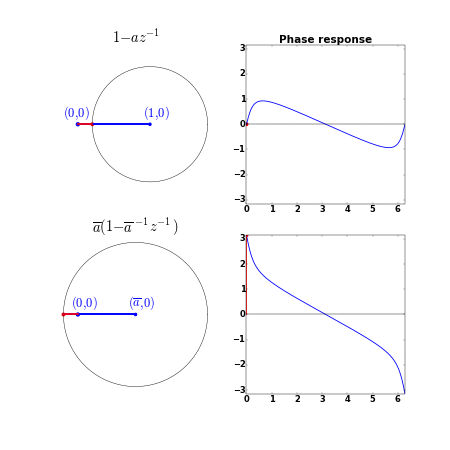 | ||
In control theory and signal processing, a linear, time-invariant system is said to be minimum-phase if the system and its inverse are causal and stable.
Contents
- Inverse system
- Discrete time example
- Minimum phase system
- Causality
- Stability
- Discrete time frequency analysis
- Continuous time frequency analysis
- Relationship of magnitude response to phase response
- Minimum phase in the time domain
- Minimum phase as minimum group delay
- Non minimum phase
- Maximum phase
- Mixed phase
- Linear phase
- References
For example, a discrete-time system with rational transfer function
Inverse system
A system
Suppose that
Applying the inverse system
So we see that the inverse system
Discrete-time example
Suppose that the system
where
Minimum phase system
When we impose the constraints of causality and stability, the inverse system is unique; and the system
Causality
and
Stability
and
See the article on stability for the analogous conditions for the continuous-time case.
Discrete-time frequency analysis
Performing frequency analysis for the discrete-time case will provide some insight. The time-domain equation is the following.
Applying the Z-transform gives the following relation in the z-domain.
From this relation, we realize that
For simplicity, we consider only the case of a rational transfer function H (z). Causality and stability imply that all poles of H (z) must be strictly inside the unit circle (See stability). Suppose
where A (z) and D (z) are polynomial in z. Causality and stability imply that the poles – the roots of D (z) – must be strictly inside the unit circle. We also know that
So, causality and stability for
Continuous-time frequency analysis
Analysis for the continuous-time case proceeds in a similar manner except that we use the Laplace transform for frequency analysis. The time-domain equation is the following.
where
Applying the Laplace transform gives the following relation in the s-plane.
From this relation, we realize that
Again, for simplicity, we consider only the case of a rational transfer function H(s). Causality and stability imply that all poles of H (s) must be strictly inside the left-half s-plane (See stability). Suppose
where A (s) and D (s) are polynomial in s. Causality and stability imply that the poles – the roots of D (s) – must be inside the left-half s-plane. We also know that
So, causality and stability for
Relationship of magnitude response to phase response
A minimum-phase system, whether discrete-time or continuous-time, has an additional useful property that the natural logarithm of the magnitude of the frequency response (the "gain" measured in nepers which is proportional to dB) is related to the phase angle of the frequency response (measured in radians) by the Hilbert transform. That is, in the continuous-time case, let
be the complex frequency response of system H(s). Then, only for a minimum-phase system, the phase response of H(s) is related to the gain by
and, inversely,
Stated more compactly, let
where
and
The Hilbert transform operator is defined to be
An equivalent corresponding relationship is also true for discrete-time minimum-phase systems.
Minimum phase in the time domain
For all causal and stable systems that have the same magnitude response, the minimum phase system has its energy concentrated near the start of the impulse response. i.e., it minimizes the following function which we can think of as the delay of energy in the impulse response.
Minimum phase as minimum group delay
For all causal and stable systems that have the same magnitude response, the minimum phase system has the minimum group delay. The following proof illustrates this idea of minimum group delay.
Suppose we consider one zero
Since the zero
The denominator and
So, a minimum phase system with all zeros inside the unit circle minimizes the group delay since the group delay of each individual zero is minimized.
Non-minimum phase
Systems that are causal and stable whose inverses are causal and unstable are known as non-minimum-phase systems. A given non-minimum phase system will have a greater phase contribution than the minimum-phase system with the equivalent magnitude response.
Maximum phase
A maximum-phase system is the opposite of a minimum phase system. A causal and stable LTI system is a maximum-phase system if its inverse is causal and unstable.‹See TfD› That is,
Such a system is called a maximum-phase system because it has the maximum group delay of the set of systems that have the same magnitude response. In this set of equal-magnitude-response systems, the maximum phase system will have maximum energy delay.
For example, the two continuous-time LTI systems described by the transfer functions
have equivalent magnitude responses; however, the second system has a much larger contribution to the phase shift. Hence, in this set, the second system is the maximum-phase system and the first system is the minimum-phase system.
Mixed phase
A mixed-phase system has some of its zeros inside the unit circle and has others outside the unit circle. Thus, its group delay is neither minimum or maximum but somewhere between the group delay of the minimum and maximum phase equivalent system.
For example, the continuous-time LTI system described by transfer function
is stable and causal; however, it has zeros on both the left- and right-hand sides of the complex plane. Hence, it is a mixed-phase system.
Linear phase
A linear-phase system has constant group delay. Non-trivial linear phase or nearly linear phase systems are also mixed phase.
